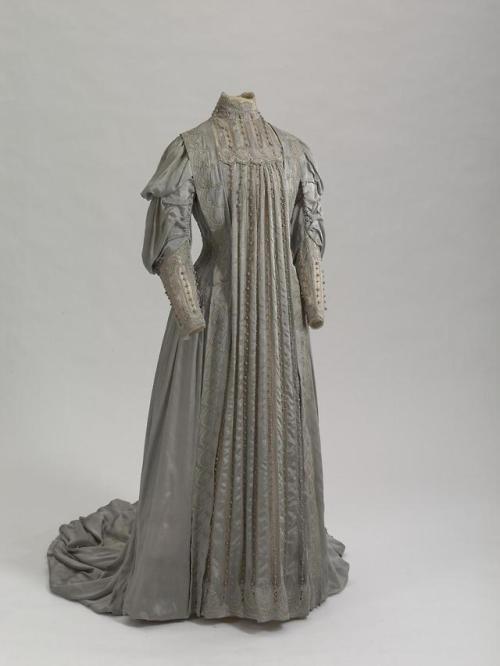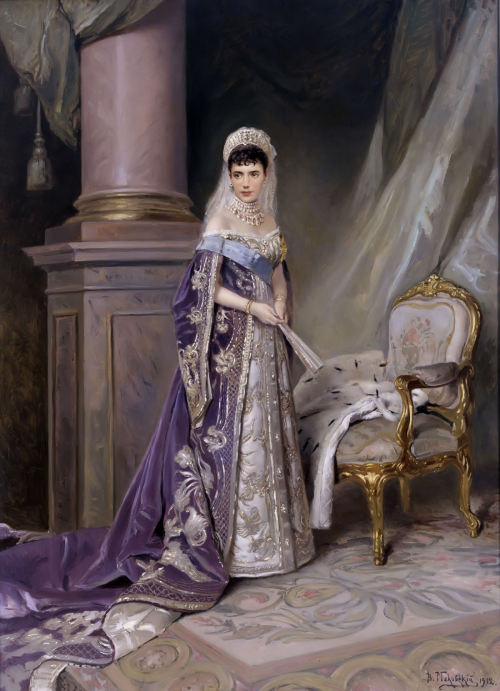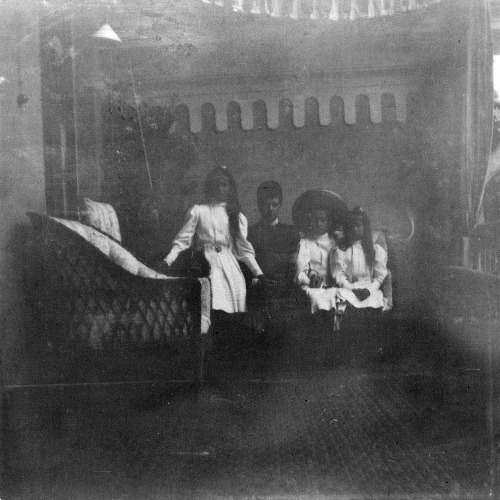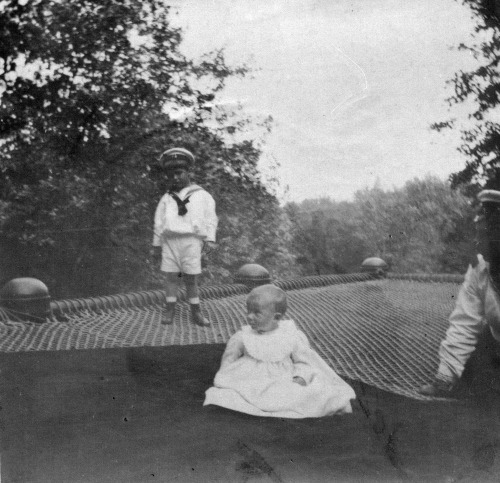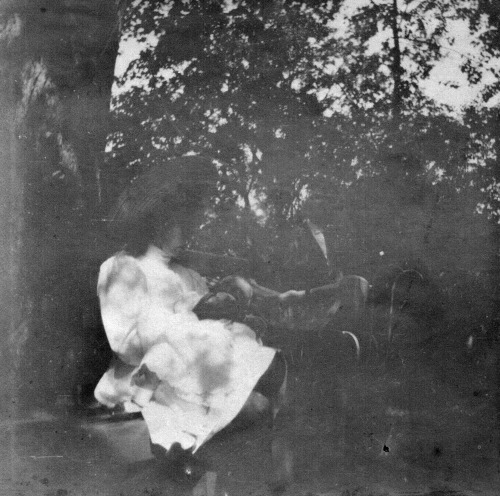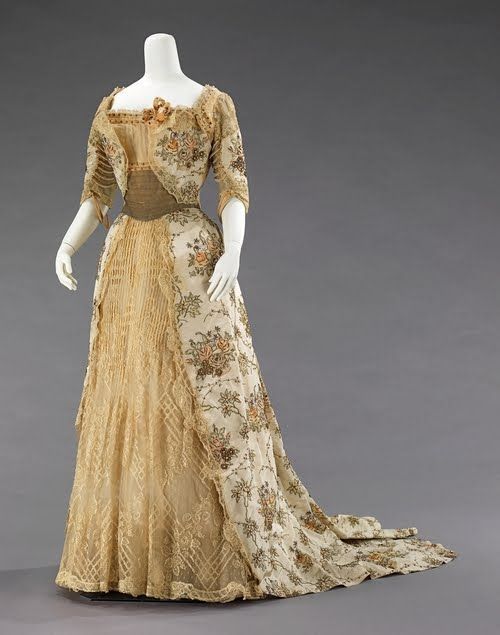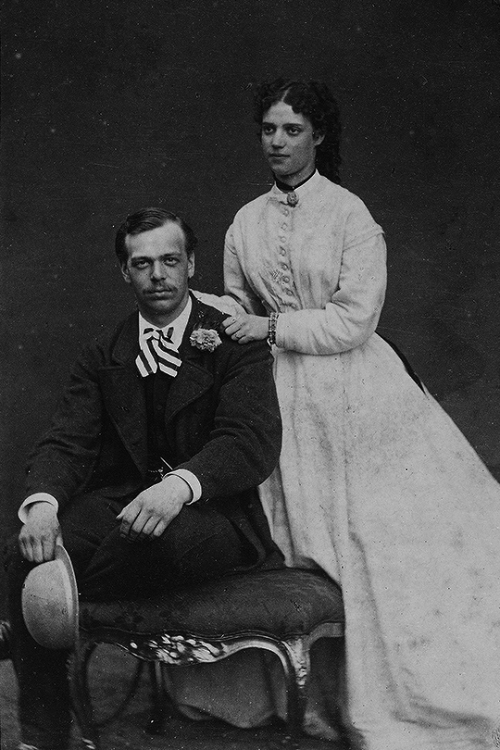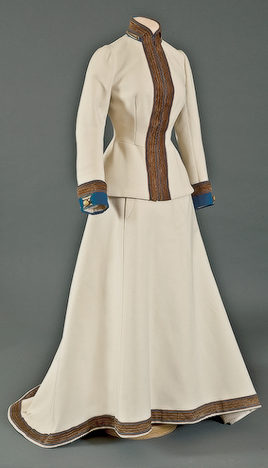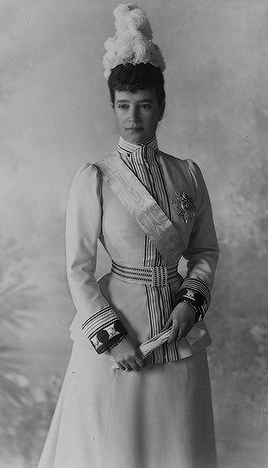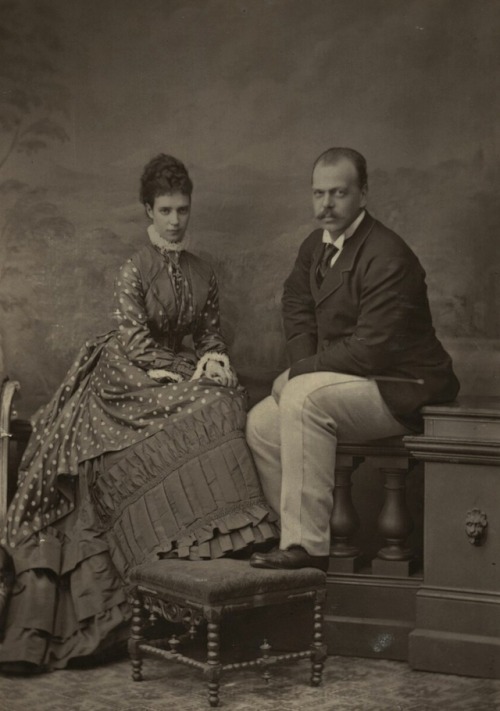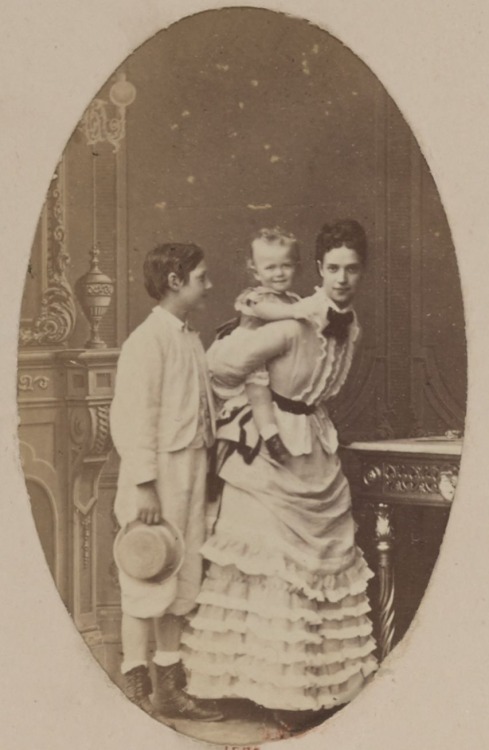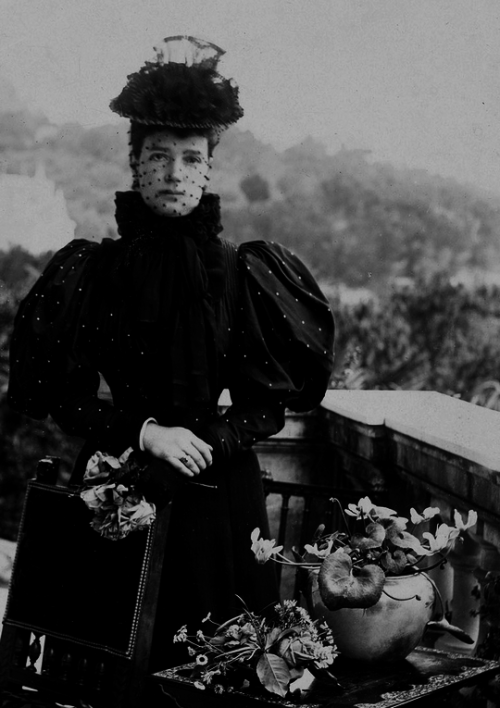#maria feodorovna
One of the last photos of Dowager Empress Maria Feodorovna (spouse of Alexander III, mother of Nicholas II) [1924] The photo was taken close to the Russian Orthodox Church of Alexander Nevsky in Copenhagen, Denmark. Assisting her is Cossack Timophey Yaschik. Yaschik was the Dowager Empress’s bodyguard and stayed with her from 1912 until her death in 1928. [source]
Post link
• House Dress of Dowager Empress Maria Feodorovna.
Place of origin: France, Paris
DesignertMaker: House of Nicaud Date: 1905-1907
Medium: Silk, chiffon, agremens, soutache.
Post link
Queen Louise of Denmark with her three daughters at the piano. From left to right are Alexandra, Princess of Wales (1844 -1925); Empress Marie Feodorovna of Russia (1847-1928) facing the viewer, Queen Louise of Denmark and Thyra, Duchess of Cumberland (1853-1933)
Post link
Photo 1 : Grand Duchess Maria Nikolaevna, Empress Dowager Maria Feodorovna, Grand Duchess Tatiana Nikolaevna and Grand Duchess Anastasia Nikolaevna on the balcony of the Cottage Palace in Alexandria Park, Peterhof 29th July 1908.
Photo 2 : Grand Duchess Anastasia Nikolaevna, Grand Duchess Maria Nikolaevna holding Prince Vasili Alexandrovich, Tsesarevich Alexei Nikolaevich, Prince Rostislav Alexandrovich and Prince Dmitri Alexandrovich playing together in Peterhof, 29th July - 5th August 1908.
Photo 3 : Tsesarevich Alexei Nikolaevich and Prince Vasili Alexandrovich in Peterhof, 29th July - 5th August 1908.
Photo 4 : Grand Duchess Maria (?) Nikolaevna holding Prince Vasili Alexandrovich in Peterhof, 29th July - 5th August 1908.
(1908 Diary of Grand Duchess Olga Nikolaevna)“29th July. Tuesday.
In the morning played with A[unt] Xenia’s children. Were at Grandmama’s. Swam in the afternoon. Mama, Papa and Alexei went to Krasnoe Selo for the night. Drank tea with S[ofia] I[vanovna]. Had breakfast with Papa and Mama.”
Photos from:
Grand Duchess Maria Nikolaevna’s 1905 - 1909 Album / pages 21 + 20b, photos 221, 219, 218, 217
Post link
“My heart is now divided into two equal parts. Happiness for me is to stay just a few more months in my parents’ home. At first you allowed me to nurture this hope, but then you suddenly took it away with your letters. At the same time the wish to be among my new family members, which I have been nurturing for so long, fills me with some kind of burdensome insecurity. But since the decision has already been made, I am thinking with gladness and happiness of my future, and hope that you will find me a worthy daughter”
_______________________________________~ From a letter by Princess Dagmar of Denmark to her future father-in-law, Tsar Alexander II ~
Theromanovfamily.com
Post link


«She never left the children brought up in her institutions afterwards, but helped them all her life, went into all the details that concerned them, and was a true mother to everyone. None of those who served her died in the palace except in her presence. She comforted everyone to the end and always closed the eyes of the dying. Doctors once told her that her retired lady-in-waiting, who lived on Vasilievsky Island, was suffering greatly from breast cancer, that it would be possible to save her, but she did not agree to the operation otherwise than if the Empress herself would be present during her production. “Well,” she said, “if only her recovery depends on it, then I will fulfill her wish.” She went to her and held her head during the whole operation.
She went into the smallest details about her establishments and not only supervised the upbringing of the children, but also did not forget to send them treats and give them all sorts of pleasures. One boy was forced to stay in bed for a long time due to illness; she brought him drawings, pencils and various things. With every courier she was informed about the state of his health — she was in Moscow at the time. When appointing honorary guardians, the choice was the strictest: she corresponded with each of them herself weekly, inquired about the pupils and pupils, about their behavior and health, and always gave wise humane advice … Everything was invented by a tender heart for the benefit, joy and peace of all who depend on her. It was not a dry, lifeless patronage, but maternal care. But her arrival at the institute was a real holiday. Maman, mam an, Mutterchen — could be heard from everywhere. Sometimes, at a big dinner, she would order dessert to be taken off and sent to some institute in turn. And she asked guardiansin her testament to remember that the first basis of all actions should be a boon!Babies abandoned by their mothers enjoyed her special attention. One day my father, who always accompanied her when she visited institutions, expressed surprise that she so tenderly kissed the little members of these unfortunate people, examined the laundry on the nurses and so on. “Ah!” she replied, “all these abandoned children are now mine and must find in me the care they are deprived of."»
(с) Maria Sergeevna Mukhanova, lady-in-waiting of Empress Elizabeth Alexeievna.


«She never left the children brought up in her institutions afterwards, but helped them all her life, went into all the details that concerned them, and was a true mother to everyone. None of those who served her died in the palace except in her presence. She comforted everyone to the end and always closed the eyes of the dying. Doctors once told her that her retired lady-in-waiting, who lived on Vasilievsky Island, was suffering greatly from breast cancer, that it would be possible to save her, but she did not agree to the operation otherwise than if the Empress herself would be present during her production. “Well,” she said, “if only her recovery depends on it, then I will fulfill her wish.” She went to her and held her head during the whole operation.
She went into the smallest details about her establishments and not only supervised the upbringing of the children, but also did not forget to send them treats and give them all sorts of pleasures. One boy was forced to stay in bed for a long time due to illness; she brought him drawings, pencils and various things. With every courier she was informed about the state of his health — she was in Moscow at the time. When appointing honorary guardians, the choice was the strictest: she corresponded with each of them herself weekly, inquired about the pupils and pupils, about their behavior and health, and always gave wise humane advice … Everything was invented by a tender heart for the benefit, joy and peace of all who depend on her. It was not a dry, lifeless patronage, but maternal care. But her arrival at the institute was a real holiday. Maman, mam an, Mutterchen — could be heard from everywhere. Sometimes, at a big dinner, she would order dessert to be taken off and sent to some institute in turn. And she asked guardiansin her testament to remember that the first basis of all actions should be a boon!Babies abandoned by their mothers enjoyed her special attention. One day my father, who always accompanied her when she visited institutions, expressed surprise that she so tenderly kissed the little members of these unfortunate people, examined the laundry on the nurses and so on. “Ah!” she replied, “all these abandoned children are now mine and must find in me the care they are deprived of."»
(с) Maria Sergeevna Mukhanova, lady-in-waiting of Empress Elizabeth Alexeievna.






«The Empress with the medical staff went around the wounded, provided first aid, tried in every possible way to ease the sufferings of the sick, despite the fact that she herself had a damaged arm above the elbow and she wore just a dress. An officer’s greatcoat was thrown over the shoulders of the tsarina, in which she walked along the crashed train…»
A. Myasnikov about Empress Maria Feodorovna on the day of the tragedy at the Borki station.


Grand Duke Nicholas Mikhailovich of Russia to Maria Feodorovna, «Various facts from November 12 to November 19, 1916»
Count Gudovich told me that his niece, the little Countess Hendrikova, told him that two ladies, i.e., A.F. (Alexandra Feodorovna) and Anya (Anna Vyrubova), had notebooks where the names of people of all classes were written alphabetically, and that in these notebooks they usually looked for people fit to be ministers. Admit that this is pure madness. There is only one remedy, Sandro and Pavel do not mind, it is for the closest, for you and your children to take the initiative to conduct a medical consultation of all our celebrities from a medical point of view, and then send them to a remote sanatorium, with or without Vyrubova, to undergo serious treatment. Otherwise, be prepared for any accidents. Tell that to Sandro-because that’s my firm opinion.
Grand Duke Nicholas Mikhailovich of Russia to Maria Feodorovna, «Various facts from December 17 to December 22, 1916»
The balding man writing to you has been thinking a lot, spending sleepless nights, running around the empty St. Petersburg embankments at dawn — and now he tells you — never look for the names of the brave souls who performed this act of civic courage, high patriotism and deliverance*. The word is silver, and silence is gold!
Madame (Alexandra Feodorovna) is madder than ever. On the night of the 19th, after the autopsy of the corpse, the order came to transport… the body of the insignificant to the emperor’s palace!!!
Two more appointments to positions took place under the influence of the murdered man …
Madame is getting more and more in charge of drowning Nicky… And time passes, gossip intensifies, the general situation inspires fears.
I’m putting the same dilemma before you again. After the hypnotist, it is necessary to try to neutralize A.F., while she is hypnotized. By all means, it is necessary to send her as far away as possible, either to a sanatorium or to a monastery. We are talking about saving the throne - not the dynasty, which is still strong, but the present sovereign. Otherwise it will be too late. … All Russia knows that the late Rasputin and A.F. are the same. If the first one is killed, the second one should disappear. The general peace of mind depends on it. …
*about Rasputin’s murder
Tsesarevich Alexander Alexandrovich and Princess Dagmar of Denmark, 1866 (x)
Alexander Aleksandrovich regarded his family as a sacred personal sphere apart from the obligation of presentation before court and state. His marital constancy developed in opposition to his father’s frivolity and fickleness. From the moment of his marriage, he entered into a loving close relationship with the grand duchess. After the wedding, he wrote, ‘It was such a pleasant and extraordinary feeling to think that finally I am married and the most important step in life had been taken.’ He described is first night with rare feeling- locking the door, the joys of the embrace, then long conversation and little sleep.
Dagmar became the kindred, sympathetic soul that had been lacking in his life. His family reflected the romantic Victorian ideal of a sanctuary for humane and tender feelings. His diary entry on New Year’s Day, 1867, recalled the bliss he had discovered on his visit to Denmark, when he met his bride-to-be. ‘I thought that I could love no more, or at least not with such passion, but I now saw and felt something completly different. I then understood the blessing and kindness of God. I then felt the meaning of true happiness.’
| Scenarios of Power: From Alexander II to the abdication of Nicholas II by Richard Wortman |
Post link
Uniform dress of the Life guards Cuirassier of Her Majesty Empress Maria Feodorovna regiment. Maria was Colonel-in-Chief of the Blue Cuirassiers, one of the Gatchina regiments. ▸Traditionnalcolorblue.
Empress Maria Feodorovna’s uniform dresses
In the pictures, Maria is wearing the uniform of the Cavalier-Guards Regiment of Her Imperial Majesty Empress Maria Feodorovna. The regiment was stationed in Saint Petersburg. ▸Traditionnalcolorred.
Post link
Princess Dagmar of Denmark, who became Tsesarevna of Russia upon her marriage
…with her enormous charm, Princess Dagmar, known as Minnie, and now Maria Fedorovna, acquired great popularity as soon as she moved to Russia. “People saw guarantee of well-being in her, and people placed all their hopes in her, and her radiant eyes lit up hearts, and her simplicity and charm promised happiness and peace […] Every heart flew to the young tsesarevna.”
She loved to swim, ride horseback, roll a hoop, and dance till four in the morning. Maria Fedorovna seemed to personify eternal youth. Knowing how important it was for her to look good in public, she paid close attention to her wardrobe. Lady-in-waiting von Flotow sent detailed description in letter to the young tsesarevna´s mother. At one Imperial ball Maria Fedorovna “stayed until 3 am and came home as fresh as a morning rose. She was brilliantly dressed again […] this time the tsesarevna was literally a rose of roses!”
Y.V. Plotnikova in Russian Splendor: Sumptuous Fashions of the Russian Court
Post link
Maria Feodorovna playing cards with her father, King Christian of Denmark, and sisters Alexandra and Thyra.
Post link
Maria Feodorovna with son the future Nicholas II of Russia and brother Prince Valdemar of Denmark
Post link
“Farewell, Princess Dagmar!
Grandeur and splendour await Thee;
Thy wedding wreath conceals an imperial crown.
Let God shine His sun on Thee and Thy new country; then, from the tears now evoked by parting,
a pearl will emerge!”–Hans Christian Anderson on the departure of Princess Dagmar of Denmark for Russia, where she would marry the future Emperor Alexander III.
Post link
Princess Dagmar of Denmark, who became Tsesarevna of Russia upon her marriage
…with her enormous charm, Princess Dagmar, known as Minnie, and now Maria Fedorovna, acquired great popularity as soon as she moved to Russia. “People saw guarantee of well-being in her, and people placed all their hopes in her, and her radiant eyes lit up hearts, and her simplicity and charm promised happiness and peace […] Every heart flew to the young tsesarevna.”
She loved to swim, ride horseback, roll a hoop, and dance till four in the morning. Maria Fedorovna seemed to personify eternal youth. Knowing how important it was for her to look good in public, she paid close attention to her wardrobe. Lady-in-waiting von Flotow sent detailed description in letter to the young tsesarevna´s mother. At one Imperial ball Maria Fedorovna “stayed until 3 am and came home as fresh as a morning rose. She was brilliantly dressed again […] this time the tsesarevna was literally a rose of roses!”
Y.V. Plotnikova in Russian Splendor: Sumptuous Fashions of the Russian Court
Post link





